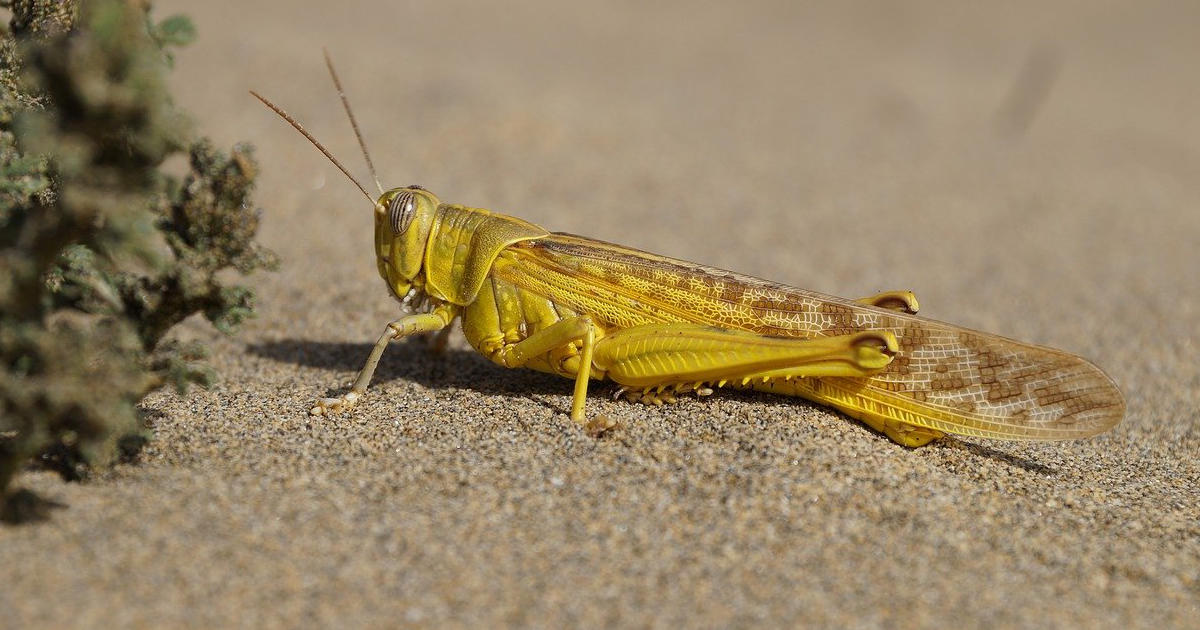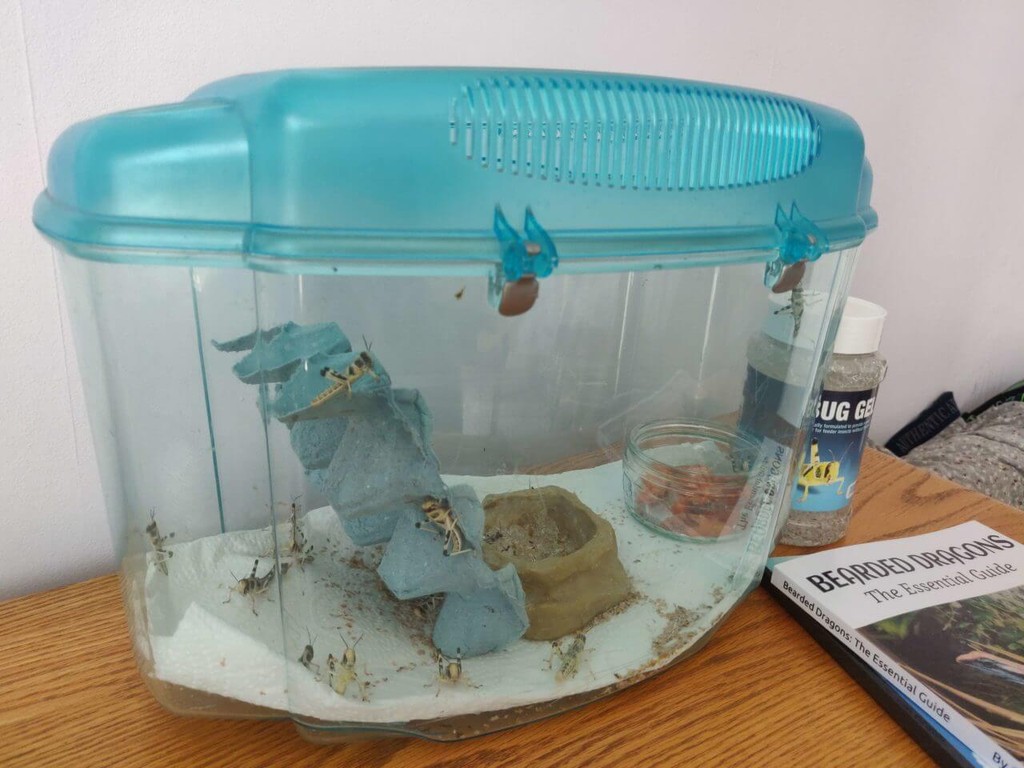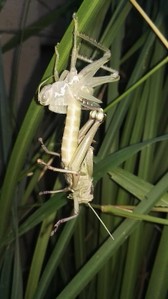Can Bearded Dragons Eat Locusts?
Can bearded dragons eat locusts? Yes, they can, and they’re a great staple food item. Learn why in this post.

Last Updated: March 14th, 2022
By: Steve
Table of Contents
Are locusts for bearded dragons OK? Can bearded dragons eat locusts? In this post we look at the reasons why locusts are great for bearded dragon insects feed and some reasons why they’re not so good. We also look at whether baby bearded dragons can eat locusts or not.
What Are Locusts for Bearded Dragons?
Locusts are a form of grasshopper, similar to crickets but generally with a longer body and smaller antennae – and with the ability to fly long distances as adults. They’re normally solitary creatures but under certain conditions they will become what is known as gregarious and this will lead them to form sometimes massive swarms.
When locusts are acting in their gregarious nature and forming the swarm they can be devastating to local crops and farmlands. These swarms are often known as plagues of locusts as a result of the devastation they can form and plagues of locusts have existed for millennia, even being mentioned in the Christian Bible of course.
The swarming phase is induced by an over-crowded population and results from the locusts touching each other regularly. This releases chemicals in the locust which changes its behaviour drastically. Swarming can occur across Africa, Asia and Australia but rarely occurs in Europe and hasn’t occurred in North America for nearly 90 years.
Locusts are also considered an edible insect species by humans and indeed even some religious groups who are generally forbidden from eating insects are allowed to eat certain species of locust. Locusts are often eaten as delicacies by being fried, smoked or dried in many places such as Africa, Asia and The Middle East. Given their abundance at times this is probably a reasonable way to help control their numbers!
Can Bearded Dragons Eat Locusts?
Bearded dragons can eat locusts regularly. Locusts and crickets are similar creatures and it’s likely that they have similar nutritional profile, although at the time of writing I’ve been unable to come across any actual studies on locust specific nutritional values.
However, locusts would be a native food choice for central bearded dragons, since locusts will swarm quite regularly in central Australia where the central bearded dragon originates from.
Locusts are quiet and don’t generally smell quite as bad as crickets. Generally, unless you’re feeding adult locusts then they won’t be able to fly. But they can jump, a long way and they’re quick. Which can present a little problem when it comes to feeding them to your bearded dragon.
They don’t bite in the same way as crickets do, and are generally less inclined to cannibalise each other in the feeder tank. They can be voracious eaters and will be nice and easy to gutload as a result. We tend to feed ours on Spring Greens and they’ll devour a Spring Green leaf in a day quite easily. This has the advantage that our old girl is eating Spring Greens even though she doesn’t realise it.
Advantages of Locusts For Bearded Dragons
Disadvantages of Locusts For Bearded Dragons
How Should I Feed Locusts To A Bearded Dragon?
Locust mobility varies with the age of the locust, with the smaller ones being less fast and less able to jump long distances. Adult locusts can, and will, fly vast distances which can make them very difficult to catch for a bearded dragon – unless they manage to sneak up on them (which many do).
For this reason it can be better to feed locusts to your bearded dragon in an enclosed container specifically designed for feeding. The container will need a lid with sufficient ventilation to allow your bearded dragon to breathe but being small enough to restrict the locusts from escaping. Containment in this way can mean that your bearded dragon will be able to hunt the locusts and be provided some stimulation as a result.
Locusts can be fed within the vivarium too. We generally do this for our girl, putting a couple of locusts at a time in the vivarium and letting her catch them herself. We don’t recommend leaving locusts in the vivarium in case they do nip your bearded dragon while they sleep – however, they don’t seem anywhere near as likely to do this as crickets do.
If you want to slow the locusts down so they don’t run or jump quite as fast and therefore escape your bearded dragon’s sticky tongue, then they can be placed in the fridge for 10 minutes before feeding. This will cool them down and make them slower.
Locusts should be dusted with a calcium supplement dust before being fed to your bearded dragon, and they can also of course be gutloaded with high calcium greens.
Hand Feeding Locusts to a Bearded Dragon
You may wonder if you can hand feed locusts to bearded dragons. The answer is yes (you can hand feed anything you want to – but beware, bearded dragons can bite (usually accidentally). Fortunately, locusts are quite long and so the likelihood of a bite is rare. The short video below shows us hand feeding Billie our aged beardie with locusts.
How Many Locusts Should I Feed My Bearded Dragon?
Locusts can be fed as a staple food item to bearded dragons. This means you can feed them as the main part of their insect diet if you so choose. We recommend feeding an adult once or twice a week, with as many as they would like to eat in a 10 to 15 minute session.
Baby bearded dragons should have insects fed to them every single day, twice or three times a day with the same sort of rule of thumb being as many as they’ll eat in a 10 to 15 minute session. Of course, when it comes to locusts it’s absolutely imperative that you choose size appropriate locusts otherwise there is a high risk of choking and/or impaction leading to paralysis or death.
For baby and adolescent bearded dragons, choose locusts which are no wider than the gap between your baby bearded dragon’s eyes. They should be able to swallow this and deal with it appropriately. Some places dispute this measuring system but it seems reasonable to us. Smaller food has less choking and impaction risk for babies so why risk larger at a delicate time in your dragon’s life.
Tips for Keeping Locusts
Locusts are extremely hardy when kept in the right conditions. Adult locusts will live for up to ten weeks in the right conditions. We tend to buy our locusts as hoppers, quite young and small. We then feed them on a diet of Spring Greens which they appear to really like. Spring Greens are perfectly safe for bearded dragons and so a gutloaded locust gives your bearded dragon some spring greens at the same time.
Find a decently sized container, with a lid and sufficient ventilation to allow the locusts to breathe. A plastic fish tank is what we use, a photo is shown below;

Since this photo was taken we’ve changed our approach slightly. We no longer use Bug Gel because the locusts never used it anyway. We now will put a whole Spring Green leaf in the tank with them – as well as the egg carton. We’ll explain the egg carton shortly.
Remove and change the Spring Green leaf if it dries out or goes yellow or becomes a shadow of its former self by being eaten. You’ll find that generally the locusts will eat the softer green parts of the leaf and leave the veins of the leaf behind.
The locusts will produce a lot of droppings when fed this way – but they do last a LOT longer when fed this way versus being fed on the dry bran that they normally come with. You will need to keep another container available to put them in as you’ll need to clean their main container every day or two.

The egg carton is important because locusts moult in order to grow bigger. To moult they will need something to hang upside down by their rear legs from. They then wriggle out of their old skin and shed it. If you’re feeding properly and your locusts are growing you’ll find an abundance of empty skins. Instead of the egg carton you can use sticks, branches or anything else they can hang upside down on.
Don’t put water dishes in as they’re silly creatures and cannot swim. They’ll fall in and drown. If you want to keep your spring greens nice and fresh, you can put them in a dish of water with the base of the stalk in the water and then cover the top of the water container with cling-film which prevents the water evaporating so quickly and stops the locusts falling in and drowning.
Our locusts last for literally months this way.
Can I Feed Dried Locusts To My Bearded Dragon?
Commercially available dried locusts are the only form of dead locust that you can feed to your bearded dragon. Though we don’t recommend dried food of any kind for a bearded dragon, there is a place for dried locusts at times. Only you will know when it’s an absolute must.
Many bearded dragons won’t even look at dried locusts. If it doesn’t move, it’s not considered food in a bearded dragon’s mind.
Dried locusts will not have the moisture content that a live locust would have, which means that feeding dried insects will result in a dehydrated bearded dragon, or one that has to be hydrated through other means.
Nutritional Data For Adult Locusts For Bearded Dragons
As we mentioned above, we’ve not been able to find decent studies for the nutrient content of locusts. Given that they’re becoming more and more popular as human foods it’s possible that this data will become available in due course. In the meantime, we present the data we could find, annotated as appropriate.
| Nutritional Item | Content |
|---|---|
| Moisture (%) | Approx. 70% (based on cricket values) |
| Fat (%) | 11.5 |
| Protein (%) | 22.0 |
| Ash (%) | 3.6 |
| Calcium (mg/kg) | Unknown at present (likely similar to crickets?) |
| Phosphorus (mg/kg) | Unknown at present (likely similar to crickets?) |
| Potassium (mg/kg) | Unknown at present (likely similar to crickets?) |
Summary
Can bearded dragons eat locusts? We’ve shown that they can, both baby and adult bearded dragons can happily eat locusts. We’ve shown that, based on cricket data they’re a good nutritional source for bearded dragons and we’ve highlighted some of the advantages and disadvantages to locusts for bearded dragons.
Frequency: Babies – staple, regularly (twice daily). Adults – staple, regularly (once or twice a week).
References / Credits
1: Abul-Tarboush, Hamza M.; Al-Kahtani, Hassan A.; Aldryhim, Yousif N.; Asif, Mohammed (16 December 2010). “Desert locust (Schistocercsa gregaria): Proximate composition, physiochemcial characteristics of lipids, fatty acids, and cholesterol contents and nutritional value of protein”. College of Foods and Agricultural Science. King Saud University.
